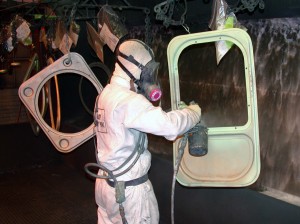
Print a Sign-In Sheet | Spanish Version Coming Soon
A spray booth, as defined by the Occupational Safety and Health Administration (OSHA), is a “power ventilated structure provided to enclose or accommodate a spraying operation to confine and limit the escape of spray, vapor, and residue, and then safely conduct/direct them to an exhaust system.” The following information outlines safe measures regarding spray booths:
Construction
- Must be substantially constructed of steel, concrete and masonry.
- If low volume or intermittent spraying, aluminum or other substantial noncombustible materials may be used. (No 2×4 framed booths).
Design
- The booth should be designed to direct air currents toward exhaust outlets.
- Interiors should be smooth and continuous, without edges, to facilitate cleaning and prevent sprayed materials from collecting in pockets.
- Interiors can be made with combustible materials, but they must be covered with noncombustible material to help with cleaning.
- Vision panels for light fixtures or observation must be made of heat-treated glass or wired glass and must be sealed to confine vapors, mists, and spray residues.
- All spray booths must have adequate mechanical ventilation. Electric fan motors cannot be located inside the booth or air duct.
- Filters should be placed so as not to reduce the effectiveness of the enclosure.
Separation of operations
- There should be no open flame or spark-producing equipment within 20 feet of a spray booth unless separated by a partition.
- No space heaters, steam pipes, or any other hot surface.
- No electrical equipment in any spray area unless specifically approved for locations with ignitable residues and explosive vapors. (*Except wiring in rigid conduit or in boxes or fittings containing no taps, slices, and terminal connections.)
- All metal parts of a spray booth shall be grounded, including any exhaust and piping systems.
Because of the variations in on-site conditions, it is impossible to cover everything you need to know about complying with OSHA’s requirements concerning the construction and safe use of spray finish booths. Please refer to CFR 1910.107 and 1910.94(c) and consult the Kentucky Office of Occupational Safety and Health (KYOSH) for assistance in applying safety and health standards and practices in your workplace.
KEMI does not assume liability for the content of information contained herein. Safety and health remain your responsibility. This information is to be used for informational purposes only and not intended to be exhaustive or a substitute for proper training, supervision, or manufacturers’ instructions/recommendations. KEMI, by publication of this information, does not assume liability for damage or injury arising from reliance upon it. Compliance with this information is not a guarantee or warranty that you will be in conformity with any laws or regulations nor does it ensure the absolute safety of any person, place, or object, including, but not limited to, you, your occupation, employees, customers, or place of business.

